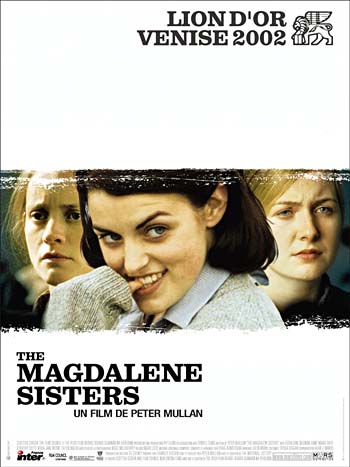The Magdalene Sisters~ Commentary on Convent Life

The Evocation of Sympathy: The Magdalene Sisters
It is apparent that Peter Mullan, the director of the film The Magdalene Sisters, attempted to portray the sisters of the Magdalene Convent to evoke sympathy from the viewer. The mothers and fathers of the convent are depicted in a dictatorial, despotic sort of way. The film is also conveyed to the reader with a sort of temporal displacement, meaning that the images which appear to the viewer could have all taken place in the mid to late 1800’s, with a couple of images of the present time thrown into the film to cause a shift in temporal dimension.
In the first scene of the film, the viewer is brought to a traditional Irish wedding, perhaps to display the reward of propriety, obedience, and adherence to the expectations of Irish-Catholic society. The remainder of the film will be scenes regarding disobedience, punishment, and a so-called penance, a non-biblical human ideology carefully mixed into Christian doctrine. The first victim of the Magdalene convent system shown in the film is Margaret; Margaret is raped by her cousin Kevin at the wedding; in showing this grotesque sexual gratification to the viewer, the director is pleading for sympathy on the part of the viewer for Margaret, to give an example of how a young woman could be institutionalized into the Magdalene convent while not being at fault for mothering a child out of wedlock. Shortly after this scene, the viewer is introduced to Bernadette, a character whom embodies the natural desire to procreate, perhaps suggesting to the viewer that these women did not deserve to be condemned for following their maternal instinct to procreate.
Then the viewer is introduced to Rose, as she sits with her mother holding her baby, before talking to Father Doonigan about adoption. Rose asks her mother, “Isn’t he beautiful”, showing a natural pride and adoration for the fruit of her loins. The mother grimaces with disgrace, and Rose replies, “You can’t blame him for something he’s nothing to do with.” Father Doonigan tells Rose that it is in the baby’s best interest to be adopted, due to the Irish Catholic ostracism of children who are born out of wedlock, which is unbiblical. Accordingly, Father Doonigan asks Rose if she would have the child pay for her sins, but living in society as a bastard child. It appears that the entire Irish Catholic faith overlooked the instance in which Jesus was writing upon the sand and observed a group of people who were ready to stone a woman who was caught in the act of adultery. When they attempted to trap Jesus so they could accuse him, he replied, “If anyone of you is without sin, let him be the first to throw a stone at her” (John 8:7). When the crowd leaves because none of them were without sin, then Jesus forgives the adulterous woman; if Jesus is able to forgive an adulterous woman, it is asinine to suggest that Jesus would condemn the fruits of such a relationship.
Similarly, the viewer is given a scene in which one of the mothers of the convent talk to the young girls who have just arrived, showing them the work that they will be doing in the convent and explaining to them what the work will mean in Irish Catholic terms. The mothers introduce the term “penance”, explaining to the sisters that they will accomplish hard work at the convent which will save them; one of the mothers called it “an earthly means to cleanse your soul.” This philosophy of penance is also unbiblical and goes against the New Testament belief that a Christian is saved by the Grace of God and through faith in Christ Jesus, and finally baptism. The book of Romans has two verses which are pertinent: “Therefore, since we have been justified through faith, we have peace with God through our Lord Jesus Christ” (Romans 5:1), and “And if by grace, then it is no longer by works; if it were, grace would no longer be grace” (Romans 11:6).
The viewer is also given a scene in which Rose wakes in the night with pains in her breasts. One of the other sisters explains that her milk is stuck, a painful sensation which comes when the mammary glands, which naturally produce milk for the new child, are not being used properly. So the viewer is given another instance in which the incarceration of the young mothers is displayed in a negative fashion.
Bernadette is depicted as a rebel. She tries to run away with Brendan, and is caught showing her legs to him by the laundress woman from within the convent. Bernadette threatens that if the woman tells on her that she’ll kill herself, and that Bernadette would go straight to hell and she would too. This is unbiblical in two ways, first in the sense that each man and woman will be judged according to his or her personal decisions and not the decisions of others, and second, suicide is never defined as a sin that entails immediate eternal fire. The idea that a man or woman suffers being cast into eternal fire immediately upon killing oneself is not biblical doctrine, and is a man-made doctrine. The only instance in the New Testament of Jesus Christ in which something even close to suicide is alluded to, aside from the infamous story of Judas Iscariot who betrayed Jesus to the authorities, is in 1st John: “If anyone sees his brother commit a sin that does not lead to death, he should pray and God will give him life. I refer to those whose sin does not lead to death. There is a sin that leads to death. I am not saying that he should pray about that” (1st John 5:16).
The scene in which the sisters are ridiculed in front of the mothers while they are naked is probably the most disturbing scene in the entire film. Crispima is given the award for having the largest breasts, for which she wails with devastation. Ultimately, the entire film is an attempt on the director’s part to elicit sympathy on the viewer’s part and to cause one to ponder the temporal paradox that such a thing could occur in our lifetimes. It is most apparent in the outcome of Crispima that the Magdalene Convents were horrid, atrocious places of blasphemy and misconduct, and brought great shame to the Irish Catholic faith and the cross of Jesus Christ.









